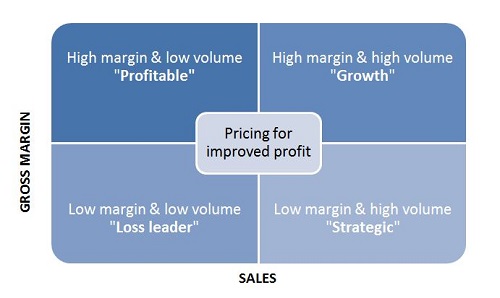Industry benchmarks
Industry standards or benchmarks can be useful to your pricing strategy. For instance, if you've worked out what price you need to apply to your goods – and the benchmarks show that on average in your industry, competitors have a larger gross margin, this may allow for you to increase your prices which will go directly to increasing profit.
Supplier markup
Sometimes suppliers have recommended retail price, which effectively means there's a fixed markup on those goods. So in this instance, you'll need to make sure your gross margin covers all your overheads at these fixed prices.
Pricing matrix
It's pretty obvious that if you're making good money on your products or service, and you can increase your sales, then profit will increase.
The pricing matrix demonstrates there are several alternatives when developing your pricing strategy. Make sure you understand where your pricing sits on the pricing matrix at all times to ensure profitability.
Profitable
Where you have a high gross margin and low volume sales – you should still deliver profit.
Growth
Where you have high gross margin and high sales volume.
Loss leader
If you choose to keep your sales prices low and you have low volume of sales, this will eventually drain cash reserves due to low profit or even losses on sales.
In some cases, businesses will offer some products at a low price with low margins – as this product offer may 'bundle up' with another product to increase sales. This is an acceptable strategy so long as it's limited to a small portion of your offer and the balance of your business is generating enough profit to cover the loss.
Strategic
Where the gross margin is kept low to attract higher volume of sales. This is often used as a strategic plan to increase market share, which can lead to the ability to increase prices down the track.
What's most important for your business is to know which products or services give you the highest profit – if you know this you can skew your marketing efforts towards these to quickly and easily increase the profitability of your business.
Savings in cost of producing
One of the more obvious areas to increase profit is to reduce the cost you pay for goods. But when you shop around – be aware of what drives your customer to buy your product or service, ensuring that lower cost goods don't impact on:
- your brand
- quality
- reputation
- other key customer requirements
If you have a good pricing strategy and follow the guidelines below, you'll be consistent with your approach to pricing – and the strategy will provide the flexibility to avoid a price war.
1. Promote the value
When looking to improve profit through your pricing, anecdotal evidence suggests you can increase your pricing by up to 5 percent without impacting on your sales.
While this may not apply to all businesses, it's important that if you do increase your pricing, you make sure the customer understands the value on offer. Don't leave it up to them to guess the value of your offer – spell it out to them. For example, you might say "this offer is worth $50, today you can buy it for $4"'.
2. Know your hidden costs
There are often hidden costs related to your products, so it's important to review all costs associated with offering your product to the market – such as freight charges, packaging, storage and insurance.
Remember that storage and insurance can add up to 30 percent to the cost of products, so include these when setting your prices.
3. Understand how discounting works
Offering discounts directly impacts your profit, so it's important that you have a grasp on how discounting works, and calculate some numbers to see if it can work for you.
4. Understand how markup is different to margin
Often business owners and managers don't understand the difference between mark-up and margin:
- Markup is the percentage applied over the top of the cost.
- Gross margin is the amount of money left to pay all the overheads.
Set a markup that will ensure your gross margin is achieved – so profits are not being eroded by inadequate selling prices.
Having a standard markup percentage across all your products may also start to eat into your profits, so look to set differing markups on differing products – particularly if some are more expensive than others to produce.
Know how your customers respond to pricing
Know how sensitive to pricing your customers are.
The product or service you offer may be a 'nice to have', which means your customers will probably consider the price when looking to purchase.
But if they're looking for a quality product or great service, they may be prepared to pay a little extra to get what they want. If they're looking at other key areas – as well as price – this will give you flexibility to differentiate your offer from your competitors.
Expand your offer
Where you have different margins on different products, this will expand your offer.
And if your competitors drop prices on a particular product, you may be able to focus your marketing efforts on other products on offer, rather than go head-to-head with your competitors.
Focus on value
Most customers have favourite suppliers or stores – and this is where you should focus your efforts.
Giving them value that differentiates your offer from your competitors will have them coming back for more – and not looking solely at the price point.
If you have a product or service line that's not profitable, don't be afraid to drop it – it's better to focus on the profit making areas of your business than chase money that's disappearing.
